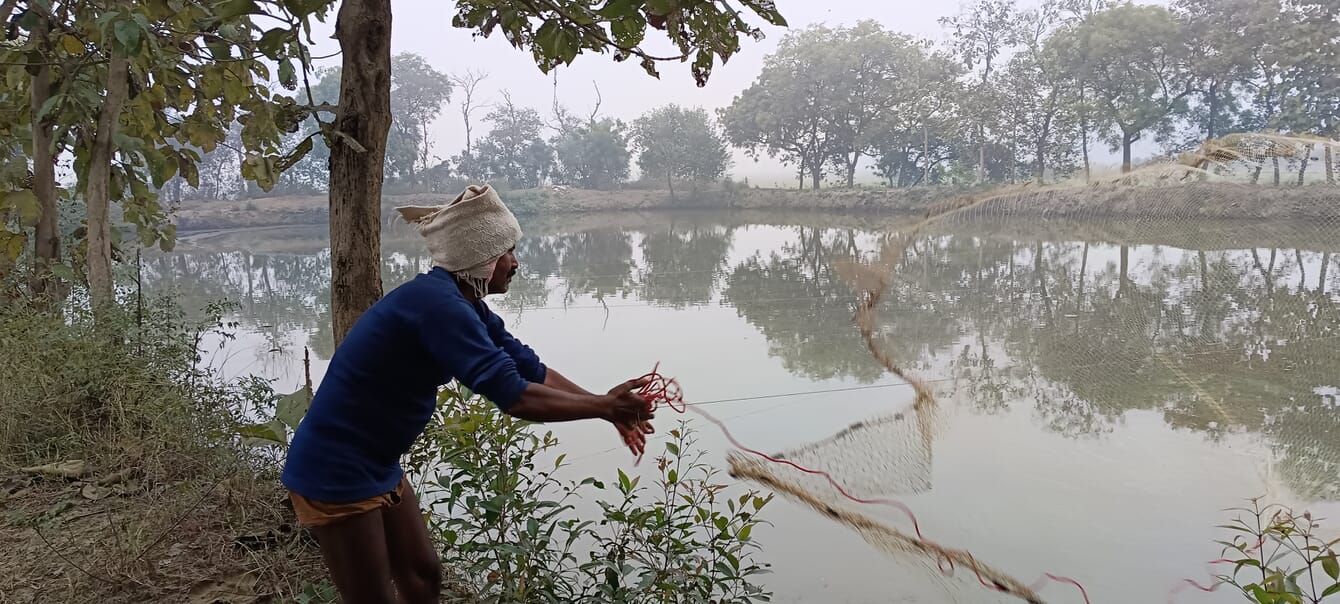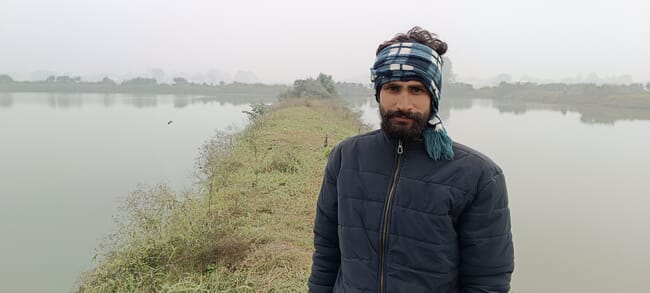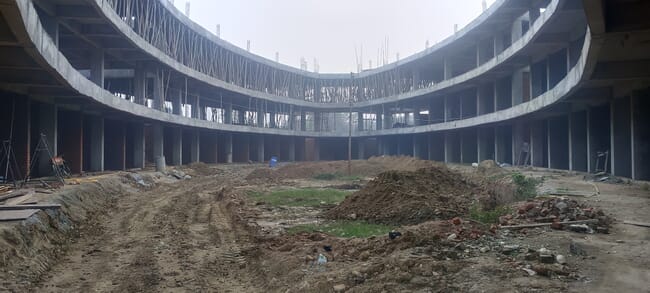
© Gurvinder Singh
Shubham Yadav is a polytechnic student in Pipani village, Chandauli district. The 22-year-old student has been desperately trying to land a government job and settle in life, but has also started fish farming on one acre of his land in case he fails to secure his dream job.
“I excavated the pond in 2022 and stocked 2,000 Indian major carp (IMC) juveniles last year. I will harvest them as soon as they reach 1 kg. I am expecting a good profit and have decided to continue fish farming. The state government also provided me with a subsidy of around 40 percent of the total cost of Rs 2.5 lakhs ($3,013) that was required to construct the pond, which also encouraged me to venture into fish farming,” he explains.
Sharad Kumar Singh, 41, who lives in the neighbouring Bartharakalaon village and who started fish farming in 2021, agrees that it can be a profitable venture - although he opted to farm a different species.
“I initially stocked 3,500 juvenile pangasius into 0.6 acres of pond and made a profit of around Rs 80,000 ($964) in the first year. I now have around 8,000 pangasius in my pond, averaging around 750-800 grams, which I will harvest soon. The production cost is around Rs 70-75 ($1) per kg, while we sell them for around Rs 100-Rs 120 ($1.45) per kilo, which brings a good profit for us,” he reflects.
Such tales of success, along with government subsidies, are inspiring more people to join the state’s aquaculture sector. According to the state fisheries department, aquaculture production rose from 740,000 metric tonnes in 2020-2021 to 940,000 tonnes in 2023, with the sector expected to reach 1.2 million tonnes by the end of this year.
“We mainly grow pangasius and IMC. But we also grow silver carp, grass carp and black carp too. We are also trying to cultivate milkfish for diversification. The total water bodies in the state cover around 10 lakh hectares, including ponds, rivers, water-logged areas, lakes and reservoirs. Around 1.25 lakh (125,000) individuals are involved in fish farming in the state and the numbers are rising by at least 10,000 every year. We estimate an income of around Rs 5-6 lakh ($6,015-7,218) per year for each family. The rate of annual per capita fish consumption has increased to 8kg, from 5 kg around eight years ago,” says NS Rehmani, joint director of UP’s fisheries department.
He attributed the increase to the better quality and price of the fish.
“We have several areas in the state where fish was not traditionally consumed, but now things are changing and people prefer fish because there has been heightened awareness that omega-3 fatty acids are good for health. The aquaculture and fisheries sector contributed $1 billion to the state economy in 2020-2021 and increased to $1.5 billion in 2023. It is rising by 25 percent every year and we aim to contribute $7.5 billion to the state economy each year by 2028.”

© Gurvinder Singh
Despite the growing success of aquaculture in Uttar Pradesh, the state is yet to become self-sufficient in fish production. The demand for fish is currently around 1.5 million tonnes whilst total production last year was under a million. The state currently fills this gap by importing fish from the southern Indian states of Telangana and Andhra Pradesh.
Uttar Pradesh currently has 324 hatcheries, of which nine belong to the state government, while the rest are private.
“The government provides a subsidy of up to 60 percent for pond construction [men receive 40 percent of the costs while women receive 60 percent] and offers technical inputs to help [farmers] learn about fish farming in order to avoid high mortality. Our stocking density is around 8,000-10,000 fingerlings per hectare and there is a strong mechanism for prevention of diseases, as there is a dedicated app where farmers notify us about the disease and then quick action is taken to control them,” says Anjana Verma, deputy planning director in the state fisheries department.
She adds that the total budget of the fisheries department is Rs 400 crore ($481 million) for 2023-24, of which 50 percent is for the subsidy alone. Additionally, the state government is also building an Integrated Fish Marketing Centre, which would be the first of its kind in the country.
“It has been inspired by Dubai fish markets and spread over an area of 1 lakh sq. ft. It would comprise wholesale and retail units, a training centre for farmers, a seafood restaurant, ice plant and freezers to keep the unsold fish. We expect to trade 50,000 to 75,000 tonnes of fish annually once the market becomes operational later this year,” says Rehmani.

© Gurvinder Singh
Government focus on fish farming
Sunil Kumar Singh, a former director of Uttar Pradesh’s fisheries department, points out that the state government has undertaken various initiatives over the past decade to promote fish production.
“Overall, 56 percent of the population in the state is now consuming fish, compared to 40 percent two decades ago. The rising demand has led to even fallow land being brought under fish farming. The government has also installed solar-powered pumps and aerators in its own farm to show that power outages and weather conditions should not be a hurdle to farming.”
Dr Shadab Masud, from the department of zoology in Banaras Hindu University, feels that the government’s establishment of fish processing units at Chandauli increases the market value of fish, while also creating employment opportunities. She also believes in the state’s potential to increase its aquaculture output.
“We are fully hopeful of achieving the target of $7.5 billion by 2028 as we would include various factors like technical, physical, quality control, seeds, feeds and proper marketing to achieve the goal,” she adds.




